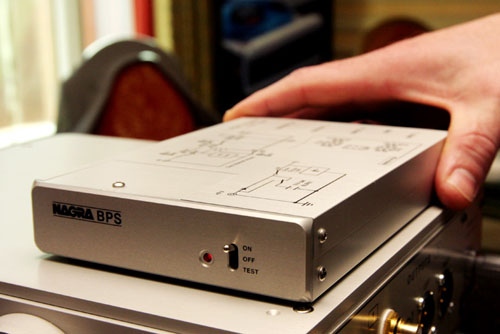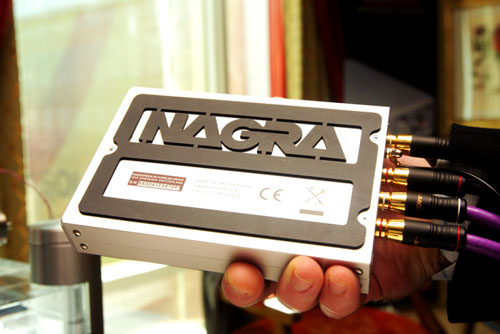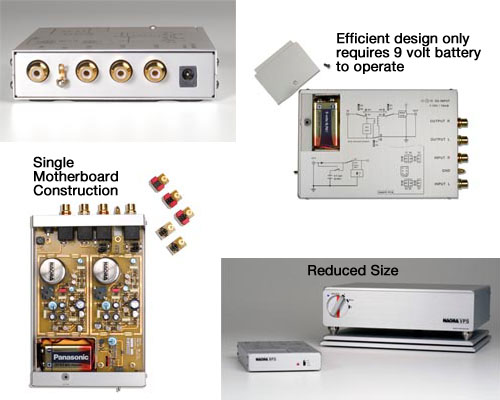Moerch DP-6 Tonearm
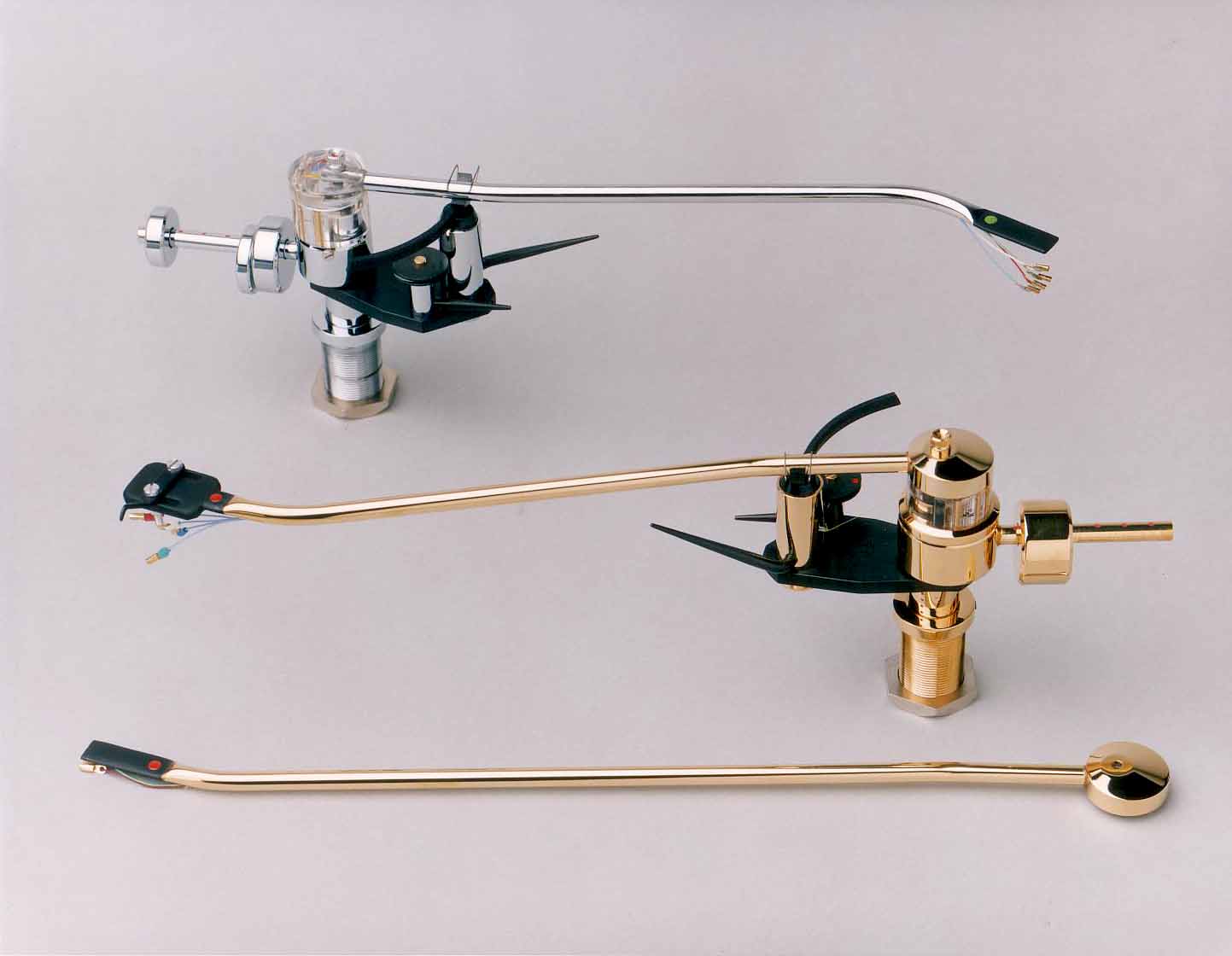 Model DP-6 has a unique combination of bearings. A silicone-damped, high precision ball-bearing assembly is used for the horizontal mode of motion. Two precision sapphire bearings are incorporated for the vertical mode of motion, which may be damped also, if desired, by injecting silicone fluid into a well for vertical damping. The damping of the horizontal mode of motion is independent of the damping of vertical mode of motion, and the latter can further be adjusted to all intermediate levels of damping.
Model DP-6 has a unique combination of bearings. A silicone-damped, high precision ball-bearing assembly is used for the horizontal mode of motion. Two precision sapphire bearings are incorporated for the vertical mode of motion, which may be damped also, if desired, by injecting silicone fluid into a well for vertical damping. The damping of the horizontal mode of motion is independent of the damping of vertical mode of motion, and the latter can further be adjusted to all intermediate levels of damping.
In model DP-6 the azimuth adjustment for perfect channel separation is accomplished at the pivot of one of the sapphire bearings.

Vertical cross section of model DP-6 through the center of the bearings.
Supplied in CHROME- or 24 carat GOLD finish and at special orders also in BLACK.
Available for audition exclusively at MKoM, Toronto.
Einstein Audio “The Turntable’s Choice” MC Phono Pre Amplifier
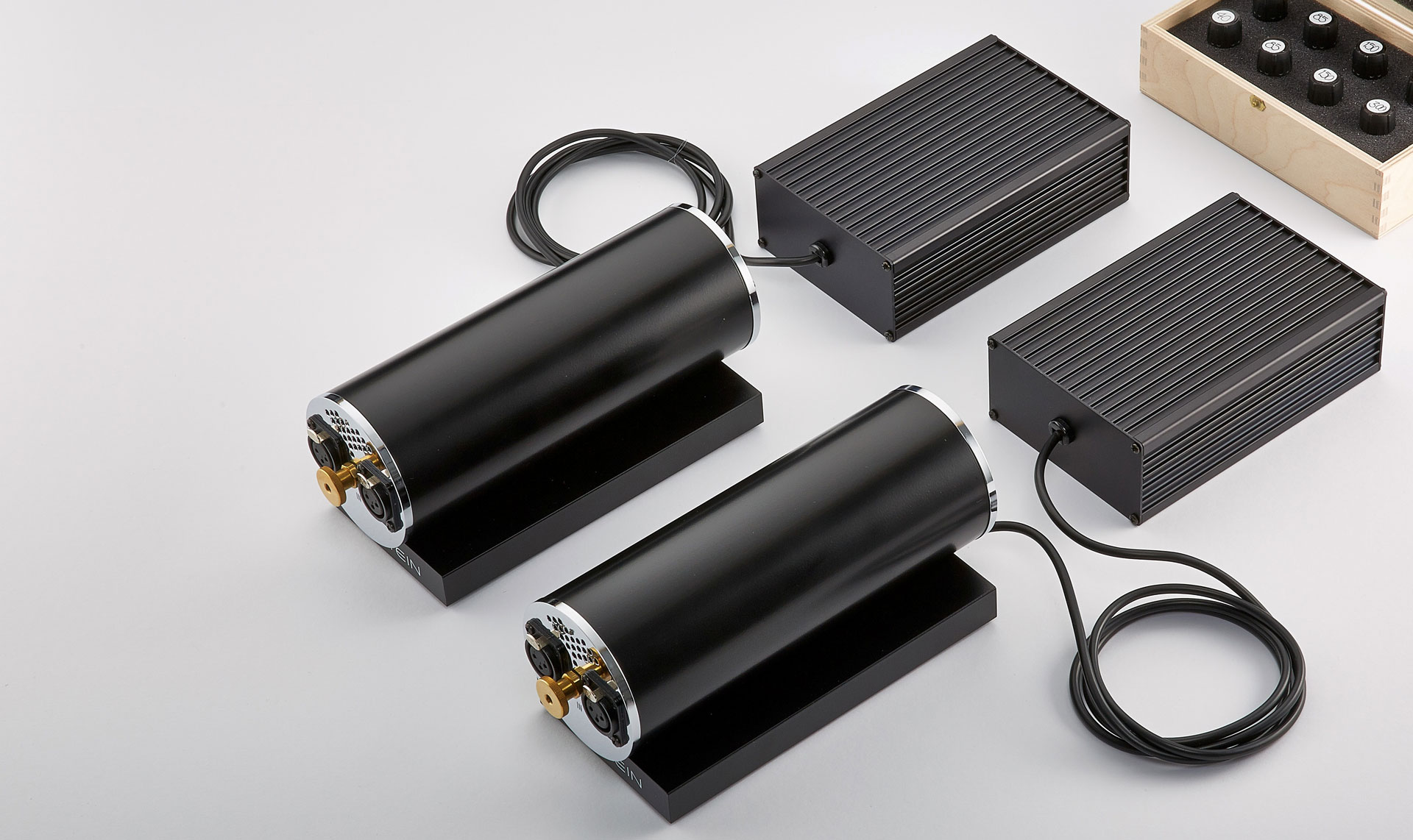
MKoM is very proud to feature Einstein’s “The Turntable’s Choice” Moving Coil Phono Pre Amplifier. We elected to showcase the Balance version which includes four chassis – Two phono stages & two power supplies.
As analogue fans with large LP collections, the development of this phono stage was an assignment close to our hearts. Because we prefer MC cartridges, the design team at Einstein set out to develop the ultimate moving-coil preamplifier. ‘The Turntable’s Choice’ inspires with its dynamic agility, precisely tracking bass lines and a vocal range that is filled with emotive tone, body and a powerful projective force, all perfectly balanced by a harmoniously effulgent treble.
Stereophile Class A Component:
“The Turntable’s Choice combined impressive detail, crystalline transparency, limitless dynamics, mouthwatering delicacy, effortless transient speed, and deep, controlled, supple bass, all combining to produce what was among the most mesmerizing analog playbacks I’ve yet heard”.
“Soundstaging and image specificity are unbelievably holographic and fleshed out”. – Michael Fremer
La Platine Verdier
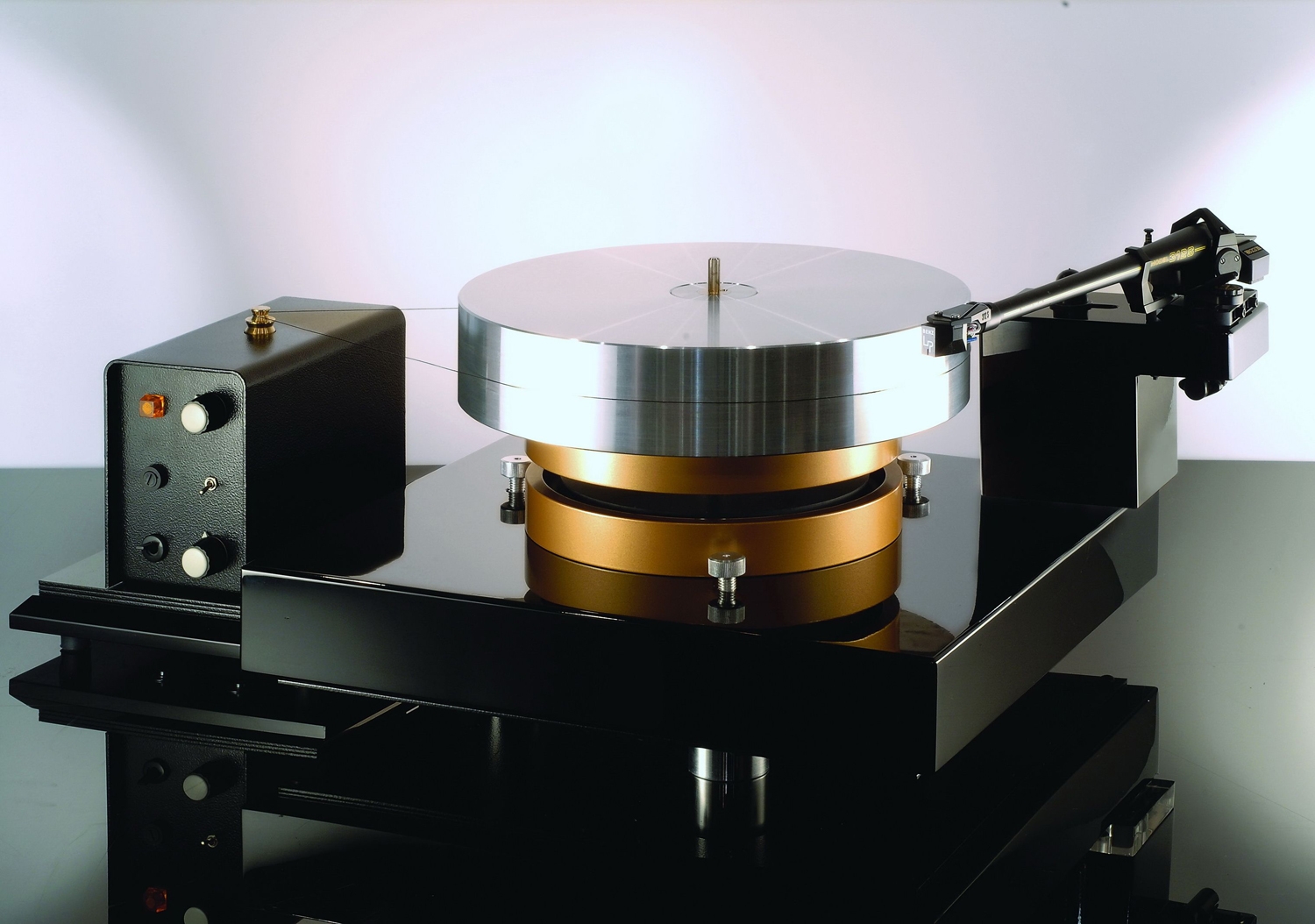
La Platine Verdier – more than 35 years and still going strong…
In France, another turntable has achieved legendary status and has proved to be a lasting and exceptional achievement – La Platine Verdier. Throughout Europe it became an essential element in the legendary demonstrations at La Maison de L’Audiophile.
La Platine Verdier – the French word “platine” (pronounced pla-teen, with the accent on the last syllable) means turntable; it was conceived by Jean Constant Verdier, so the name means the Verdier turntable – was first presented to the public in 1979.
The Platine Verdier’s success story is written by its proud owners and daily users. We are happy to have contributed to that story; that a product is still going strong after more than 25 years in a fast-changing market is testament to its stature and value.
Available through My Kind of Music.
Dr. Feickert Adjust Plus+
From the graphs you can see the phase error at 0 degrees azimuth was huge: 155 degrees! Where the curves in the upper graph cross at -1.4 degrees azimuth angle, there is zero phase error, which is readily audible to the untrained ear. The crosstalk figures at this azimuth setting reflect improvements up to 7 dB, which again is huge! (a 10 dB difference is twice or half as loud) The ear is more sensitive to phase error than crosstalk, so -1.4 degrees was selected as the optimum azimuth setting.
From the moment the stylus hit the groove, the differences were mind boggling. Everything from top to bottom was clearer, better defined, with dramatically less noise and grain. The client raved about it the improvements and continues to say how it’s almost as if he’s hearing each record again for the first time. He laughed, saying he never would have deliberately put the cartridge and arm at a funny angle like that, but sure enough he heard the difference right away. Every client has said the same things. We’re batting 1.000!
Whether the perfect azimuth setting for your system is as little as a few tenths of a degree from where it is now or even more than what’s shown in this example, you’ll hear the improvements time and again. Your favorite records will last longer, and so will your stylus.
It’s truly the biggest bang for the buck improvement you can make to your system. Your ears will thank you!
For further information, kindly refer to: http://www.adjustplus.de/index.php?lang=english
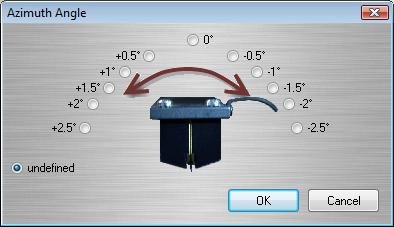 An example of what the correct azimuth setting will do for you
An example of what the correct azimuth setting will do for you
The client in this case listens to vinyl only and carefully maintains his records and keeps his equipment in perfect adjustment. Accordingly, the cartridge body was perfectly level, parallel to the record surface.
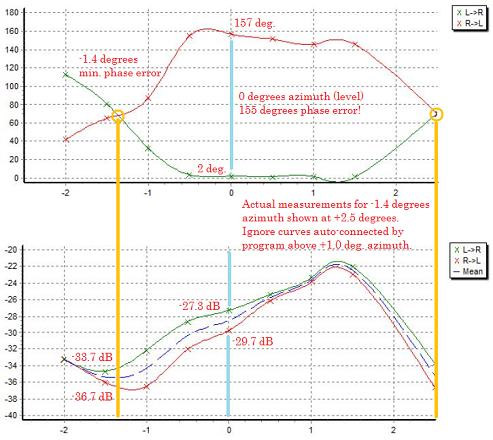
The graphs above, generated by the software program, show the phase response (upper graph) and crosstalk (lower graph) measurements taken for different azimuth angles (shown on the horizontal axes). The light blue vertical lines highlight the measurements taken at zero degrees azimuth angle, the initial setting, while the yellow vertical line toward the left side of the graphs highlights the measurements taken at the optimum azimuth angle of -1.4 degrees. Because the software program is configured for azimuth angles in 0.5 degree steps, for measurements at the final azimuth setting of -1.4 degrees we “pretended” to the program that the azimuth was at +2.5 degrees — a region that’s not of interest since crosstalk is increasing for positive azimuth angles and phase error is relatively unchanging.
Origin Live
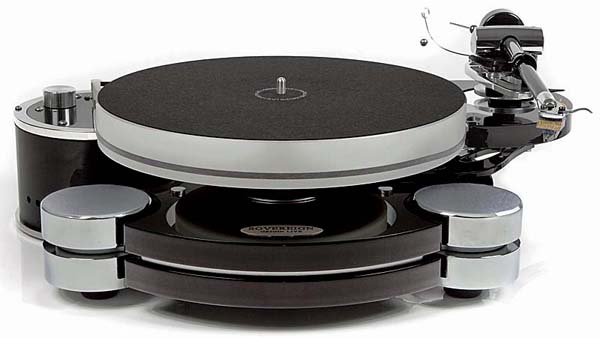
Origin Live aims to enrich your musical enjoyment through offering the highest grade products to a standard that outperforms your expectations. The new generation of turntables from Origin Live are the result of continuous development that have pushed back the boundaries on sound quality by significant leaps and bounds.
We believe, as do many experts that vinyl records still represent the ultimate format for sound quality and will continue to do so for many years in spite of all the new “super” formats. The ultimate format deserves the ultimate player and this is what we have dedicated ourselves to achieve at very modest sums. Not only is vinyl the best format available but you may have a decent collection of priceless records that you wish to appreciate to their full. These are a few of the reasons for the enormous investment that has been made in producing these decks. We trust that you will be surprised in the best possible way once you hear them.
Available through My Kind of Music; for more information visit the manufacturer’s site: http://www.originlive.com
Nottingham Dais
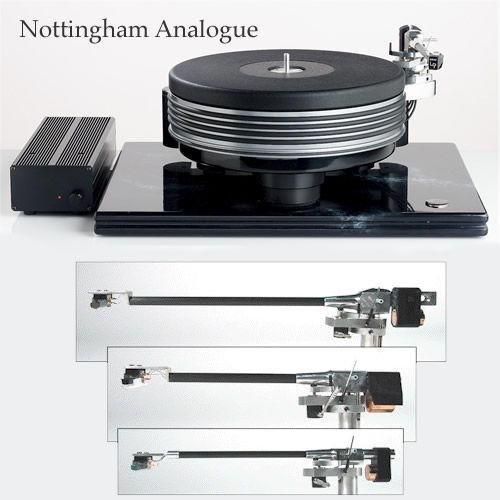 Nottingham Dais
Nottingham Dais
Nottingham Analogue’s recently developed Dais is the ultimate turntable upgrade. The Dais, pictured below, is Nottingham’s elite performance table, offerings ultra-high-end performance approaching the Anna Log but in a less elaborate more affordable package.
Dais – a raised platform for the conductor of an orchestra. Nottingham Analogue had a very successful turntable of this same name which they stopped making in 1978. There are still many happy Dais owners enjoying their music on these machines.
The new Dais replaces the Mentor turntable. After 19 years the Mentor was dropped because its old chassis could not incorporate Nottingham’s new thoughts on music extraction.
Nottingham Analogue has always been concerned with what people stand their turntables on, especially glass and spikes, so the base board for the new Dais consists of a relatively thin platform base under which there is a 90% covering of damping material. When this damping material is put onto the chosen surface there is more of a ‘marriage’ between the turntable and surface.
Many ideas have spun off from the Anna Log, Nottingham’s top turntable until the recent debut of the Decco, – the back parallel arm mounting structure controls much of the resonance without taking the mass, relying on 80% of the mass resonance to be transferred to one adjustable front leg. The motor is conveniently out of sight in the preferred position at the back. A very similar male/female bearing arrangement is used from the Anna development – a unique levelling device is also fitted to the bearing, which is factory set but can be altered by the owner if necessary.
The massive 20kg of gravity spun iron platter, with one of the highest inertia of any turntable on the market today, gives solidity and a picture of a performance with remarkable diction. Sitting on top of this platter is a 25mm thick graphite ‘mat’, along with the anti-expansion bands this adds the final damping to the platter.
The Wave Mechanic power supply works extremely well and doesn’t rob us of dynamic range, and achieving this is no easy feat! The power supply is total – that is mains power goes in but completely regenerated power and frequency comes out to the turntable. The Dais can accommodate two arms, and is very easy to set up and level.
“Let the music begin”
Nottingham Tonearms and Accessories
ACE Space arm upgrades – June 2006
All Nottingham arms are a unipivot design. Unipivots are usually designed with the pivot sitting in a silicone bath. The problem with this design is that the silicone bath takes quite a while to settle down and so the arm will change in sound as it plays the record. Many unipivots also use the offset stabilizer weights or eccentric counter weights to insure proper azimuth.
Nottingham has cleverly solved this common problem. Nottingham arms use side stabilizer bars and tiny ball bearing chases to maintain azimuth. Nottingham has also developed a proprietary damping material the viscosity of which is such that it does not flow and does not require ‘settling time’. This material is applied to the centre pivot and the stabilizer bars. Nottingham uses carbon fibre tubes with the fibres oriented the length of the tonearm not wrapped around it. This greatly increases the strength, resonance control and rigidity of the arm.
Nottingham also uses an unusual headshell design. The headshell has an orientation that is in direct line with the tonearm and not offset in any way. The headshell also has no finger lift. These two features insure that the arm is properly balanced from side to side and that no uncontrolled resonances are running around the headshell.
The Interspace arm has many of the performance features of the more expensive arms, specifically; long grain carbon fibre, unipivot design and in line headshell.
The ACE Space arm has the same basic performance features as above. This arm uses the same long grain carbon fibre tube but also uses a second tube as a liner. This helps dramatically with both rigidity and resonance control. The ACE Space also uses a threaded allen screw to make the selection and adjustment of VAT a simple step.
The Space 294 arm is basically the same as the ACE Space but in a twelve inch length. The added length reduces the tracking error. This arm was designed specifically for the Space 294 table.
The two Anna arms (12″ or 10″) were upgraded based on the success of the ACE Space arm. The Anna arms are Nottingham’s current statement, combining all the damping and strengthening techniques they know to give an illusion of music that is totally non-fatiguing.
“All our arms sound the same – ‘a family of sound’ – we think they have to, if they didn’t some would be right and some would be wrong. Whether you buy an Interspace arm or Anna arm the differences will be very subtle but very worthwhile having. We can listen to an Interspace arm for hours otherwise we would not attempt to put it on the market. Happy listening!” – Tom Fletcher
Wave Mechanic Power Supply
The Wave Mechanic external power supply, pictured to the left of the Dias at the bottom of the ‘Introducing Nottingham’ page, was made especially for Nottingham Analogue and comes standard with the Dias and Anna Log tables.
This power supply improves sonic performance by eliminating all kinds of electrical problems which can plague your hi-fi. The Wave Mechanic can be purchased separately as an upgrade for any Nottingham turntable and will provide a clean waveform with stable voltage and frequency.
The power supply has a frequency adjustment knob so you can set the speed of the precisely and thus obtain perfect pitch. (A hand held strobe illuminator is included.)
The audible benefits of the power supply are very clear. Detail, dynamics and sound stage are all much improved, but perhaps the most evident feature is the way that the whole pace and rhythm of the music sounds natural and true. Pitch stability is impeccable, giving complete confidence and much deeper involvement in the musical performance.
These benefits should not be expected to replace those from upgrading the turntable, but rather to complement them. All of the Nottingham Analogue turntables will benefit, whether your current one or your next one.
Nottingham Analogue Space 294
 Supremely Musical World Famous Turntables
Supremely Musical World Famous Turntables
Nottingham Analogue is a well respected British manufacturer of high quality, specialty audio products. For over 35 years Nottingham engineers have been producing innovative designs which excel at allowing the music to come through in its purest form.
Their turntables are known for precision and purity, ultra quiet noise floor, supreme musicality, quality build and remarkable value.
“All our products sound the same, the only difference is there is less and less fatigue and you get a little bit closer to the illusion of real live music the higher you go up our product ladder.” – Tom Fletcher, engineer/owner, Nottingham Analogue Studios.
Space 294
This highly innovative design has all the above mentioned improvements but the ‘294’ also has a 14″ platter giving much more rotational stability due to the additional inertia. The turntable is specifically for 12″ (294mm) tonearms only and cannot be fitted with a second tonearm.
Twelve inch tonearms are nothing new for Nottingham Analogue, the longer arm results in a smaller tracking error, and Nottingham has cleverly eliminated the pitfalls of common 12″ tonearms.
The new Space 294 will get you closer to the illusion of real music than you ever thought possible at a price that will send you record shopping with a smile on your face.
Mystic Mat MKII
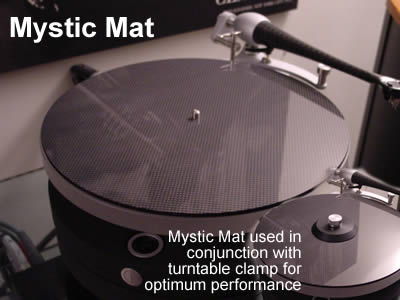 A viable necessity for the discerning music lover.
A viable necessity for the discerning music lover.
We’re not afraid to boast this, but we believe the Mystic Mat & Mystic Mat II will redefine the art (and science) of listening to your cherished vinyl…forever! Here’s a deceptively simple turntable mat that embraces the analog-loving listener with a smooth, rich sound complete with impressive subtleties and detailing that competing mats can’t touch! Imagine improvements in frequency extension and low-level resolution without tonal imbalances, increased dynamic range that’s rich and unrestrained, bass that’s really there when it needs to be there, and 3 – dimensionality that’s so close to being dead-on…need we say more! IT’S THAT GOOD!
When we auditioned this remarkable product we were pleased to see that the Mystic Mat exhibited every bit of the manufacturer’s claims (as well as Michael Fremer’s assessment in his August ‘Analog Corner’ column), but what we didn’t expect an even more exciting improvement when we used the clamp with the mat! Smoother bass, cleaner highs, and an even more spacious background! You’ll have to experience the results with or without the clamp, but either way you won’t be disappointed! Its sturdy and well-built design mean this product is going to be part of your turntable for many years to come.
The Mystic Mat is composed of a layer of gel-coated resonance-controlling carbon fiber mated to a layer of CF polyurethane and followed by another sheet of carbon fiber. It’s thin (4mm) profile makes it a perfect candidate for any ‘table needing immediate musical improvements from conventional felt or rubber record mats. It fits snugly on your turntable’s spindle and lies nice and flat on the platter with the smooth side down. Simply place your LP on top of the contoured surface, place the stylus on the grooves and get ready for a dose of musical reality! Available in 3mm, 4mm & 5mm thicknesses.
Transfiguration Cartridges
 What an exciting time it is for analog playback! At a time when people thought it would be long-since dead, LP playback, like the legendary Phoenix, rises far above the digital domain. This is truly its golden age. LP playback technology has never been more vital. One might be grateful that digital playback has improved drastically since the time it was pronounced “perfect music, forever…” In fact, it was dreadful. Now, it almost sounds like music and is beginning to approach the realm where analog playback was back then. A huge improvement. However, in that same space of time, analog playback of the LP has seen far more drastic and rapid improvements. Thanks to dedicated, passionate and innovative designers, like Seiji Yoshioka of Immutable Music, producers of the Transfiguration cartridges, and Armando Conti of Basis Audio, LP playback has achieved heights never imagined back in the days that bit-counters and bean-counters were pronouncing it dead.
What an exciting time it is for analog playback! At a time when people thought it would be long-since dead, LP playback, like the legendary Phoenix, rises far above the digital domain. This is truly its golden age. LP playback technology has never been more vital. One might be grateful that digital playback has improved drastically since the time it was pronounced “perfect music, forever…” In fact, it was dreadful. Now, it almost sounds like music and is beginning to approach the realm where analog playback was back then. A huge improvement. However, in that same space of time, analog playback of the LP has seen far more drastic and rapid improvements. Thanks to dedicated, passionate and innovative designers, like Seiji Yoshioka of Immutable Music, producers of the Transfiguration cartridges, and Armando Conti of Basis Audio, LP playback has achieved heights never imagined back in the days that bit-counters and bean-counters were pronouncing it dead.
With his groundbreaking utilization of the yokeless ring-magnet construction, Mr. Yoshioka presented the LP world with a new window into the music buried in the black grooves of the vinyl LP. His first product, the Transfiguration AF-1, set completely new standards of transparency, naturalness and neutrality for phono cartridges of its day. Since that time, he has constantly striven to bring the listener ever closer to the sounds and emotions of the live event. Constantly improving materials and construction techniques, he has since set the pace and defined the state-of-the-art for natural-sounding LP reproduction. His Transfiguration cartridges, using live, unamplified music as their benchmark, do not take LP reproduction into the realm of the hyper-real, with sizzling technicolors, exaggerated leading-edge transients, “enormous soundstaging,” “pinpoint imaging,” or “lush warmth.” Instead, they deliver a very natural and alive-sounding reproduction of what the recording engineer heard, as he or she sat in the recording booth, listening to the master tapes. Audiophile language does not seem to apply, rather, musical language seems more apt. “Rhythm, flow, emotion…” are the kinds of words that come to mind, as one notices a foot is tapping and the head is bobbing and maybe even a few goosebumps are rising…
but, as always, the magic is in the midrange. Human voices take on a you-are-there sense of reality that raises those goosebumps. When you hear things you have never heard from your records before, you can be sure they will help to complete the musical picture, rather than distract with meaningless detail or artificial “air.” The transparency of these cartridges extends from the deepest bass notes to the heights of inaudibility. More than ever, they are able to track the micro-dynamic ebb and flow of the music like no other cartridge. The result is a sense of musical anticipation and excitement one normally experiences only at the live event. Listening to jazz, you can almost smell the cigar smoke and single-malt whiskey in the air; a classical LP calls forth images of rich velvet curtains and wisps of fine perfume; rock and roll brings back the moisture of the grass seeping through your jeans and the smell of sweat and something sweet upon the breeze…
NAGRA BPS (Bi-polar Phono Stage)
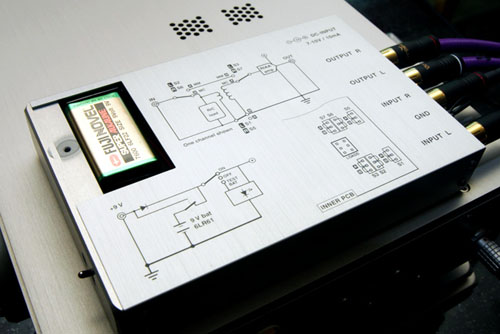 What’s remarkable about the Nagra BPS phono stage is not its small size, although that’s certainly attention-grabbing. instead, it’s the circuitry and well-considered features that are squeezed into this hand-sized chassis that make the BPS noteworthy.
What’s remarkable about the Nagra BPS phono stage is not its small size, although that’s certainly attention-grabbing. instead, it’s the circuitry and well-considered features that are squeezed into this hand-sized chassis that make the BPS noteworthy.
The BPS uses essentially the same circuit as Nagra’s VPS phono stage, but it omits the VPS’s tubes. Like the VPS, it uses custom Nagra step-up transformers to derive its gain — 45 to 60dB, making it suitable for use with moving-coil cartridges. It runs on a nine-volt battery, although wall power is also an option.
The reduced size of the Nagra BPS phono preamplifier is the result of using completely solid-state technology, less costly to implement than Nagra’s valve phonostage version. The BPS electronics consumes so little power that it operates for approximately 100 hours on a single 9-volt battery. Due to using a battery power supply, there is no need for a costly external power supply that is complex to manufacture. The Nagra BPS enjoys an attractive positioning thanks to a simplified approach as regards functions. Nagra however retained the popular load adaptation found on the VPS model, which uses small plug-in modules to attain the desired matching between the phono preamplifier and the specific cartridge. Nagra’s BPS supports either moving-coils (MC) or moving-magnet cartridges (MM) by means of appropriate switching. Assembled on a single motherboard, the electronics use exclusively discrete and military-type components (JAN standard). The amplification is provided by selected and matched bipolar transistors. The capacitors on the signal path are of audiophile quality and the precision resistors are MELF (Metal Electrode Leadless Face). The MC input transformers are designed and wound by Nagra. All components are housed within a Nagra style brushed aluminum case.
